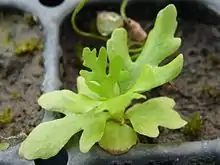Ceratopteris thalictroides
Ceratopteris thalictroides is a fern species belonging to the genus Ceratopteris, one of only two genera of the subfamily Parkerioideae of the family Pteridaceae.[2]
| Ceratopteris thalictroides | |
|---|---|
 | |
| Ceratopteris thalictroides, showing typical above-water foliage | |
| Scientific classification | |
| Kingdom: | Plantae |
| Clade: | Tracheophytes |
| Class: | Polypodiopsida |
| Order: | Polypodiales |
| Family: | Pteridaceae |
| Genus: | Ceratopteris |
| Species: | C. thalictroides |
| Binomial name | |
| Ceratopteris thalictroides (L.) Brongniart | |
Common names
It is commonly known as water sprite, Indian fern, water fern, oriental waterfern, and water hornfern. In the Philippines it is called pakung-sungay (literally 'antler fern' or 'horn fern').[3]
Distribution
Pan-tropical. Widespread.
Description
Plants usually rooted in mud, very variable in size and appearance, scales on rhizome peltate, thin, translucent, pale brown, (under a lens clear with dark cell walls) stipes 3 – 15 mm diameter in mature plants, spongy and air filled, sterile fronds pale green, thin, flaccid and spreading, 4 – 60 cm long, including a stipe c. half this length, fertile fronds pale green, to brown when over mature, firm, held erect, 15 – 100 cm or more long, including stipe to 40 cm long, proliferous or dormant buds with overlapping dark scales sometimes present in the axils of fertile pinnae (twice seen), sterile axes obviously winged, pinnae basically broad-ovate or deltoid with a few blunt lobes, sometimes more deeply incised, the segments 2 - 15 x 10 – 30 mm, fertile segments linear, 1 - 2 x 10 – 80 mm.[4]
Recent chromosome counts have shown that the north type and the third type both have chromosome counts of 2n=156, while the south type has a count of 2n=154, making it definitely a separate species.
Ecology
Swampy areas, swamp forests, sago (Metroxylon) swamps, marshes, natural and man-made ponds, mostly in stagnant water bodies or in still pockets along slow flowing rivers, full sun to moderate shade, from sea level to 1300 m, but mostly less than 500 m altitude. Sometimes massed on or around logs or other floating vegetation, once recorded in a fresh-water mangrove (Sonneratia) growing among the finger-like pneumatophores. In some areas Ceratopteris exhibits a degree of seasonality, reaching maturity and shedding spores during the dry season; plants have lost nearly all sterile fronds by this stage.[4] The species has been reported to functionally be an annual, repopulating from spore the next season, but it is clearly of indefinite lifespan in cultivation.
Uses
Culinary
Fronds are cooked and eaten as a vegetable in Madagascar,[5] New Guinea, and Vietnam,[6] and raw as a salad in Micronesia. However, the plant is believed to contain carcinogenic chemicals.
Cultivation
It grows best in soil with a pH reading of 5-9 and in very high amounts of light. It usually grows quickly.
Ceratopteris thalictroides can benefit (like all aquatic plants) from the addition of CO2. The plant's reproductive technique is similar to other ferns. Small adventitious plantlets are grown on the mother plant and are then released when ready.
It can provide useful shade to shyer fish and small fry. The dense roots are said to take nutrients out of the water helping to prevent the growth of algae.
See also
References
- Irudayaraj, V. (2011). Ceratopteris thalictroides. The IUCN Red List of Threatened Species 2011: e.T168862A6541936. https://doi.org/10.2305/IUCN.UK.2011-1.RLTS.T168862A6541936.en. Downloaded on 25 October 2018.
- PPG I (2016), "A community-derived classification for extant lycophytes and ferns", Journal of Systematics and Evolution, 54 (6): 563–603, doi:10.1111/jse.12229, S2CID 39980610
- Pteridophyte and Gymnosperm Diversity in Musuan, Bukidnon. Victor B. Amoroso, Philippine Journal of Systematic Biology, June 2007; Accessed December 2010
- Ceratopteris thalictroides Archived 2007-11-05 at the Wayback Machine in Australian National Herbarium
- Grubben, G.J.H. & Denton, O.A. (2004) Plant Resources of Tropical Africa 2. Vegetables. PROTA Foundation, Wageningen; Backhuys, Leiden; CTA, Wageningen.
- Tanaka, Yoshitaka; Van Ke, Nguyen (2007). Edible Wild Plants of Vietnam: The Bountiful Garden. Thailand: Orchid Press. p. 108. ISBN 978-9745240896.
- Barry James (1986). A Fishkeeper's Guide to Aquarium Plants. Salamander Books, London & New York
